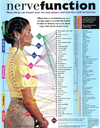The chiropractor that I'm seeing has some posters in his practice that address emotional and stress and how that can impact the alignment of the spine. We can apparently subluxate ourselves as a stress or trauma response.
He had heard of polyvagal theory, but admitted that he doesn't know much about it. He did, however, say that he recognises sympathetic dominance patterns in spinal alignment. Said that he treats a woman with PTSD, and after her first few adjustments she mentioned that her night terrors had stopped. He can also tell now when he assesses her spine before each adjustment whether her night terrors have returned.
Last visit, he mentioned the
SD Protocol (SD for Sympathetic Dominance). This protocol was developed by a chiropractor, Dr Wayne Todd, when he recognised the match between posture/spinal alignment, hormonal problems, gut problems, and neurological problems. I'm just early into following up on this material and at the moment it seems as though Todd has not taken PVT into account in his system as he is operating under the old paradigm of sympathetic and parasympathetic in tension with each other. Still it's helpful to know that posture can impact wellbeing and maybe even access to ventral vagal state.
At this point I can say that Todd, and my chiropractor, believe that a 'head forward' posture indicates sympathetic dominance and that 'tech neck' can actually put a person into a sympathetic state. There may be more postural clues revealed as I delve into the material. Dr Todd says that for each cm that the head deviates forward, the misaligning force on the spine increases by 4kg. This is an easy one to get an objective measure on. Have someone take a side-on picture of you standing beside a perpendicular upright like a post or door frame. Ideally you should be able to draw a straight line from ears, through shoulders to hips.
I imagine that misalignments due to stress or trauma might also create a feedback loop where misalignments trigger a warning that something is wrong internally and that might add to the overall given what Porges says about neuroception where the nervous system is on the lookout for welcome or warning signals internally, in the environment and between people.
I haven't read Dr Todds book yet, also available on amazon, but am watching one of his lectures on the video below. If interested, start the video at around 15:15 as before that they are dealing with tech problems etc. that haven't been edited out.
One of the other ways that I think paying attention to posture aside from health and ANS impacts might be helpful is that in the work on the Persistent Predatory Personality, apparently one of the clues that these people use to distinguish possible easy prey is posture and gait.
The other thing I like about the chiropractor that I'm seeing at the moment is that he can give very objective feedback. In the initial physical/neurological assessment he had protractor to measure and record angles compare the differences on each side of my body and to an ideal, as well as a ruler to measure and record distances. He requested xrays and has marked on them a blue line to show ideal alignment, and a red line to show my current misalignments and subluxations. All of these measurements will be repeated after 3 months.
He feels that I'm moving faster through the adjustments than what is common for my age group. Said if he saw my spine in a 20yo, he would be aiming for around 2 months of adjustments, in an 80yo around 2 years. So he figured initially that I'd need somewhere between 12 to 18 months of adjustments, but will revisit that after 3 months. As he's aware of sympathetic dominance, he has started with lighter adjustments to prevent too much sympathetic arousal. That process might be assisted by my knowledge and application of polyvagal theory. He is interested to know more about PVT so I will lend him Deb Dana's flip chart which is what she uses to teach her clients about the ANS through the PVT lens.



 I don't know how helpful this comment will be but once I switched jobs, everything pretty much went away, even the GERD-like symptoms that started after the mask mandates at work in 2020. The ocular migraines stopped too. My body was definitely saying NO!
I don't know how helpful this comment will be but once I switched jobs, everything pretty much went away, even the GERD-like symptoms that started after the mask mandates at work in 2020. The ocular migraines stopped too. My body was definitely saying NO!